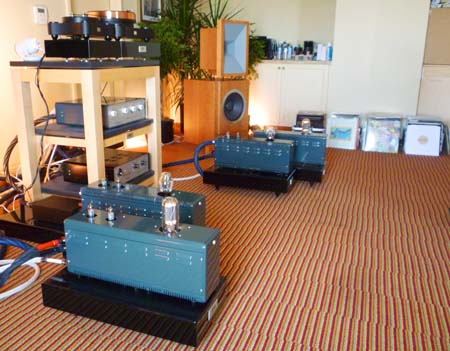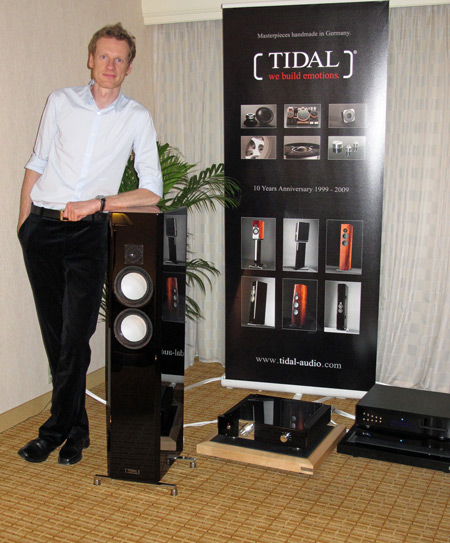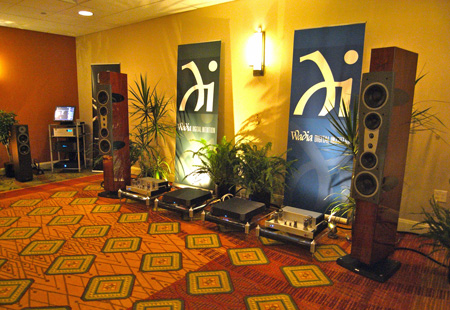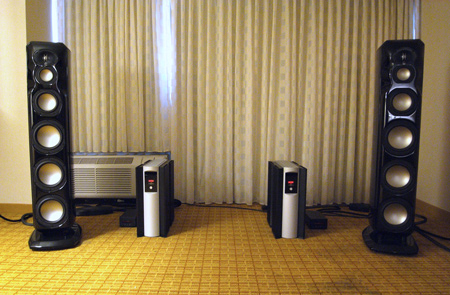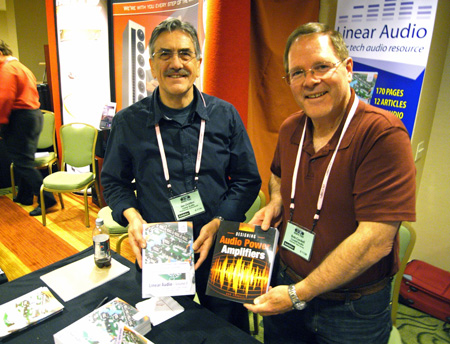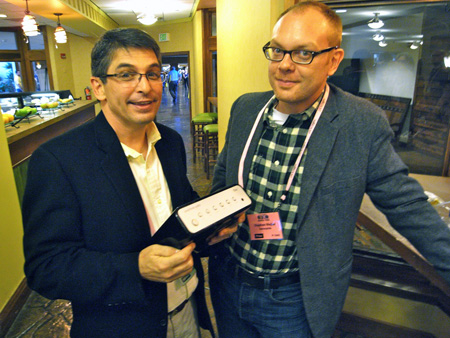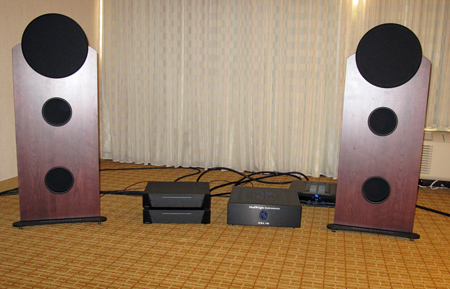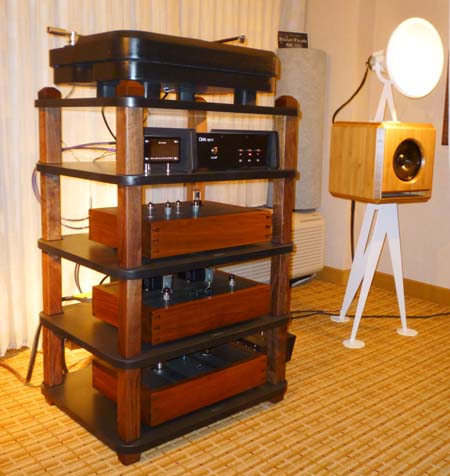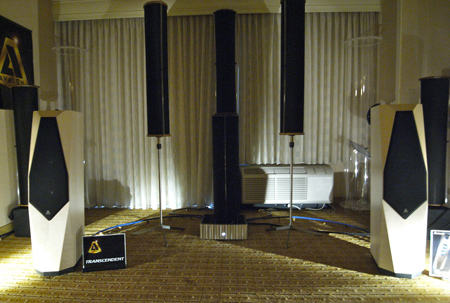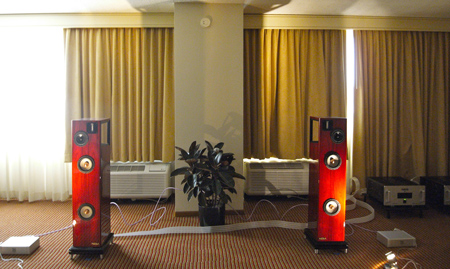LATEST ADDITIONS
Tidal's "We Build Emotions" Touch My Own
Some of my happiest sonic experiences at RMAF arrived in the last two rooms I visited: the Tidal Audio/Argento Audio Cables/dCS showcase put together by Doug White of The Voice That Is (Newton Square, PA), and the Simon Yorke/CAT/Synergistic/Lansche exhibit assembled by Tim Nguyen of <A HREF="http://blog.stereophile.com/rmaf2010/tone_of_music_sings/">Tone of Music</A> (San Francisco, CA).
Dynaudio - Wadia - Octave
Perhaps the best sound I heard at RMAF was in the large room on the mezzanine shared by Dynaudio, XLO, and Wadia. The Dynaudio Confidence C4s ($20,900/pair), which I first <A HREF="http://www.stereophile.com/floorloudspeakers/794/">reviewed in March 2003</A>, were sounding as good as I remember them sounding in my own room, perhaps even better. The rest of the system was obviously high-class: a Wadia 971 CD transport ($17,950) fed Wadia's Series 9 Decoding computer ($33,450, comprising the 931 controller and dual-mono 922 DACs), which in turn fed Octave MRE130 tubed monoblocks from Germany ($16,000/pair) sitting on Grand Prix amp stands. Cabling was all by XLO. The 130W Octave amplifiers use two pairs of KT88s in push-pull and the wideband output transformer has a single tap. The amp can also use 6550s or EL34s, and an accessory "black box" increases the B+ storage capacity.
Revel & Mark Levinson
One of my two best sounds at RMAF was from Revel's Ultima Salon2 speakers ($22,000/pair), which have been favorites of mine since <A HREF="http://www.stereophile.com/floorloudspeakers/608revel">Larry Greenhill's review</A> appeared in the June 2008 issue of <I>Stereophile</I>. At RMAF, the Revels were being driven by Mark Levinson No.53 monoblocks ($25,000/pair), which in turn were being fed straight from the variable output of a Mark Levinson No.512 SACD player ($15,000). Cabling was all-Transparent. The superbly stable soundstaging extended beyond the physical positions of the speakers, the tonal balance was one of the most neutral I heard at the Show, and the bass was both extended and defined. I would have stayed listening for longer, but the Show only had 30 minutes more to run and I had two more rooms to visit.
Audio Design from Jan Didden & Bob Cordell
DIY hi-fi used to be an important aspect of audio magazine content 30 and more years ago, but these days it has migrated almost completely to the Internet, with just Ed Dell's <I>AudioXpress</I> magazine still waving the roll-your-own flag in print. Sharing a stand at RMAF were two of the Internet's most notable DIY engineers, Jan Didden from Holland (left) and Bob Cordell from New Jersey (right), and both were venturing into the print medium. Bob had advance copies of his new tome <I>Designing Audio Power Amplifiers</I> for sale, which I will be reviewing in <I>Stereophile</I> early in the New Year. Jan had the first volume of his new bookzine <I><A HREF="http://www.linearaudio.net">Linear Audio</A></I>, which has articles on audio design from Bob, as well as Doug Self, Joachim Gerhardt, Nelson Pass, Siegfried Linkwitz, and many others. But if you have any interest at all in the nuts and bolts of audio design, don't wait for my reviews of these books; check them out for yourself. There's audiophile gold within their pages!
The Peachtree iDAC
Peachtree's David Solomon, seen here accosting <I>Stereophile</I>'s Stephen Mejias (right) in the hotel's coffee bar, was in ebullient mode. He's holding Peachtree Audio's new idAC ($999), which combines the usual 24/192kHz S/PDIF inputs with a 24/96-capable USB input and an iPod dock that, like the Peachtree iDecco amplifier that is favorably reviewed by Art Dudley in our December 2010 issue, takes the audio data from the iPod in digital form. The iDAC uses the latest version of ESS's 32-bit Sabre<SUP>32</SUP> D/A chip.
Emerald Physics
Due to all the positive reviews Emerald Physics loudspeakers have earned, it took several attempts over a three-day span until the crowds in the two Emerald Physics rooms had thinned down enough to allow a brief listen.
Oswalds Mill Audio
Oswalds Mill Audio is doing something refreshing and beautiful, combining brilliant industrial design with a classic sense of style and a deep love for music.
Avalon Transcendent
Nola & Audio Research
New York-based Nola was showing its Metro Grand Reference speakers at RMAF ($25,000/pair). Combining a Raven ribbon tweeter and a 4" midrange, both mounted on an open baffle, with two 6.5" reflex-loaded woofers, this slim tower, driven by an Audio Research Reference 210 power amplfier, Reference 5 preamplifier, and CD8 CD player via Nordost cabling, produced more bass than I thought possible, given its modest drive-unit array. The response is specified as being 6dB down at a low 26Hz. This was one of several systems at RMAF using the Quantum QX4 AC treatment device from Nordost.

